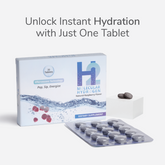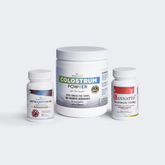Estimated Reading Time: 10 minutes
|PMS (Premenstrual syndrome) is not simply about being moody, cranky, or emotional. But like many, you may also consider PMS as “just part of being a woman’ and you’re just dealing with it, right?
You remember that strange rollercoaster behavior of yours, being rational on Tuesday and sobbing at something silly by Thursday? Trust us, it’s not weakness, it’s biology.
“With an estimated worldwide prevalence of 47.8%, PMS affects almost one in two women, highlighting its significance as a global health concern.”
And around 3–8% women in their reproductive age face PMDD (Premenstrual Dysphoric Disorder), the far more severe version linked to suicidal thoughts and crippling emotional pain.
Yet, for years, women’s symptoms have been minimized, dismissed, or misunderstood. Maybe you’re told to pop an ibuprofen, grab some chocolate, or simply wait it out.
In every circle of friends, there’s likely someone silently suffering, and maybe you’re that someone. And things become different once you’re 35. So, whether you’re below 35 or above, let’s understand PMS together and know what you can do about it.
Common PMS Symptoms You Might Recognize
PMS shows up differently for every woman, but here are the most common symptoms:
-
Mood swings (feeling irritable, emotional, or on edge)
-
Anxiety or low mood
-
Fatigue and low energy
-
Trouble sleeping
-
Cravings for sugar or carbs
-
Headaches or migraines
-
Bloating and water retention
-
Breast tenderness or swelling
-
Cramps and back pain
-
Digestive changes (constipation or diarrhea)
-
Brain fog or difficulty focusing
PMS Decoded: Your Body’s Monthly Stress Signal
For most people, PMS just means mood swings or cramps. But do you know there’s a fascinating (at times frustrating) science behind this stereotype?
Happening 1-2 weeks before your period, PMS is the result of natural hormone fluctuations in the luteal phase. During this time, estrogen dips and progesterone rises (or falls abruptly). These shifts directly affect brain chemicals like serotonin and GABA (Gamma Aminobutyric Acid), the very messengers that regulate your mood, sleep, and cravings.
Now you’ve a scientific answer to those who say PMS is ‘all in your head’ or that you’re ‘just being dramatic.’ Your brain during PMS is literally different from your brain during the rest of the month.
If your life is out of balance, like from stress, poor sleep, or nutrient gaps, PMS will magnify it. Remember, PMS is not about what happens during your period but what happens before. Once bleeding begins, hormones reset and symptoms usually ease.
You can consider PMS as your body’s alarm system that tells your hormones, brain chemistry, and daily habits are clashing. It’s a warning sign spotlighting stress, nutrient gaps, inflammation, or emotional overload. Simply put, it’s your body’s way of communicating that something needs your attention.
Also Read: 7 Signs of Hormonal Imbalance
Why PMS Hits Harder After 35?
Do you know why PMS symptoms after 35 feels more intense? There are reasons why your body demands more support after 35. Check them below:
-
Hormone changes begin earlier: Although menopause is still away, your 30s and 40s bring subtle hormonal changes that you know as perimenopause. Progesterone production begins to decline with inconsistent ovulation. All the hormonal disturbances result in mood swings and breast tenderness.
-
Metabolism slows down: With age, the risk of insulin resistance increases. When your cells don’t respond well to insulin, it can disrupt normal ovulation. And without regular ovulation, your body doesn’t produce enough progesterone. Low progesterone is a major reason PMS symptoms can feel stronger or last longer after 35
-
Stress piles up: By 35, most women are usually juggling careers, families, aging parents, or financial pressure. With severe PMS, things become more difficult.
-
Sleep debt catches up: Over the years, all those late nights, caffeine, and stress finally start showing up as fatigue, irritability, and brain fog during PMS.
-
Nutrient depletion is real: Years of dieting, stress or eating too much processed food can quietly drain your body of essential nutrients. They usually have low magnesium, B vitamins, and omega-3s, all essential for smooth hormone regulation.
Also Read: What to Know About Female Sex Hormones
Cracking the PMS Code: What Your Symptoms Are Telling You
Instead of seeing PMS as random chaos every month, try looking at symptoms as clues. These clues aren’t random. Each symptom points to an underlying imbalance your body wants you to notice. Here’s what each symptom may mean:
-
Bloating: It may be your gut signaling inflammation and sluggish digestion.
-
Cravings: It’s usually your body’s way of begging for missing nutrients like magnesium or protein.
-
Fatigue: It’s not laziness. It’s a red flag that your energy systems, thyroid, mitochondria, and adrenals are under strain.
-
Breast Tenderness: It’s a classic sign that estrogen is dominating progesterone.
-
Low Mood: A dip in serotonin (a brain chemical that helps regulate mood) can leave you feeling down, less motivated, or more emotional than usual.
-
Anxiety: Blood sugar swings can make your brain feel unstable.
-
Brain Fog: Brain fog may strike when stress hormones like cortisol and hidden inflammation disrupts brain signaling. This makes it harder to focus, remember, or think clearly.
Amazing Tip: Keep a PMS diary for 2-3 months. Add detailed notes like “Headache at 2 pm, craved for ice cream, snapped at my child.” Over time, you’ll notice patterns resulting in a detailed monthly report.
What are the Hidden Triggers that Make PMS Worse?
PMS doesn’t just hit hard due to hormone shifts. Modern lifestyle habits often make it worse. Lack of sleep, stress, processed food, or too much caffeine can quietly affect your hormonal balance without you realizing it. Have a look at the hidden triggers that you may not know but are making your PMS worse:
-
The Sugar Trap: That sugary treat may feel comforting at first. But the sugar spike and crash may make PMS mood swings, irritability, and cravings even worse.
-
Caffeine Dependency: Your daily coffee isn’t always the villain, but timing matters. Coffee can interfere with iron absorption when taken alongside iron-rich meals, and low iron levels can worsen fatigue and PMS discomfort. For some people, high caffeine intake may also amplify stress sensitivity, making PMS feel more intense
-
Exercise Imbalances: Pushing too hard at the gym without proper recovert may raise cortisol. On the other hand, too little movement makes you feel sluggish. Finding the balance helps your body cope better during PMS.
-
Missing on Sleep: Every hour of lost sleep builds up over time. During PMS, you feel really drained.
-
Screen Time Strain: Too much blue light from phones and laptops disrupts melatonin (sleep hormone) and throws off your circadian rhythms (body clock).
-
Inflammatory Foods: For some women, hidden food sensitivities (like dairy, processed food, or gluten) can flare up bloating, cramps, or mood swings.
If you’re able to identify one or two triggers that affect your PMS, it may help you, since small changes can build into massive relief.
Natural PMS Solutions That Actually Work
Now let’s get to the part that you’ve been waiting for. But let us tell you that there are no one-size-fits-all solutions. It’s all about building lifestyle habits that help over time. Being consistent is the key when it comes to natural PMS relief solutions.
1. Lifestyle Hacks for Busy Women
-
The 10-minute morning routine: Sunlight exposure, deep breathing, and gentle stretching can reset hormones faster.
-
Gentle movement: Walking, yoga, stretching, or Pilates can ease PMS without triggering stress hormones.
-
5-minute stress reliever: Even 5 minutes of box breathing (a deep breathing technique that involves inhaling, holding, exhaling, and pausing, each for 4 seconds), or journaling can help regulate cortisol and ease symptoms.
-
Evening wind-down ritual: Dimming lights, limiting screens, sipping herbal tea, and meditation prepare your body for restorative sleep.
2. Nutrition Must Dos
-
Magnesium: Often called nature’s chill pill, magnesium helps relax muscles, eases cramps, and calms down your nervous system. Try magnesium-rich foods such as leafy greens, nuts, legumes, seeds, whole grains, and high-quality supplements.
-
Omega-3s: These fatty acids are known to lower inflammation and support brain health. You can try wild salmon, flaxseeds, or clean supplements.
-
B Vitamins: Essential for energy and neurotransmitter balance, these vitamins are helpful if you’re always tired or cranky.
-
Calcium: Include calcium-rich foods in your diet. In case your diet lacks sufficient calcium, you can go for its supplements.
-
Cycle-syncing meals: Prioritize proteins and complex carbs in the luteal phase to stabilize blood sugar and mood.
Also Read: Best and Worst Foods for Hormonal Balance
3. Mind-Body Connection
-
Use cycle tracking apps: They help you plan around PMS.
-
Try Mindful practices: Meditation or guided relaxation really works, even if it is for 5 minutes.
-
Say No without guilt: Let your body rest as protecting your energy in the luteal phase is self-care, not selfishness.
Remember: You don’t have to do it all. Just choose two habits that feel doable and be your own ally every month.
Conclusion
PMS doesn’t have to be like your monthly punishment. When you understand what’s really happening, you can go from being frustrated to being empowered. Know that your symptoms are not your enemy; they are indeed silent clues about what your body needs more (or less).
So, start listening to your body’s signals. Mood swings, cravings, bloating, or brain fog aren’t signs of your weakness; they’re your body’s way of telling you need care. With nourishing food, mindful habits, and small lifestyle shifts, you don’t just survive PMS, you thrive through it.
Disclaimer: This blog is for informational purposes only and does not provide medical advice. Always consult a healthcare professional before making changes to your diet or health routine. Individual results may vary.
Frequently Asked Questions
Q1. How to reduce premenstrual syndrome?
You can ease PMS by making lifestyle changes such as eating a balanced diet, staying active, getting quality sleep, managing stress, and limiting caffeine, alcohol, and salty foods. Some women also find relief with supplements like calcium, magnesium, or vitamin B6, but it’s best to check with a healthcare provider before starting any.
Q2. When does PMS start?
PMS usually starts a few days to two weeks before your period and goes away once menstruation begins.
Q3. What can make PMS worse?
Stress, lack of sleep, poor diet, caffeine, alcohol, and hormonal changes can worsen PMS symptoms.
Q4. Does PMS get worse with age?
Yes, PMS often gets more intense in your 30s and 40s as hormones shifts happen and you approach perimenopause.
Q5. Can PMS cause anxiety?
Yes, hormonal changes during PMS can trigger mood swings, irritability, and anxiety in some women.
Q6. How long can PMS last?
PMS symptoms can last anywhere from a few days up to two weeks before your period. But if your symptoms feel severe, overwhelming, or interfere with daily life, it may be something more than PMS — such as PMDD (Premenstrual Dysphoric Disorder). In that case, it’s important to speak with your doctor for proper evaluation and support.
References:
-
Tawakoli, Mohammad Farid, Abdullah Abed, and Rohullah Sakhi. "Prevalence of Premenstrual Syndrome (PMS) Among Female Biomedical Students in Kabul, Afghanistan: A Cross-Sectional Study." International Journal of Women's Health (2025): 1911-1922.
-
PMDD Facts and Statistics.” Verywell Health, 12 Jan. 2024, www.verywellhealth.com/pmdd-facts-and-statistics-6361195
-
Wang, Yuru, et al. “Premenstrual Syndrome and Premenstrual Dysphoric Disorder Prevalence and Associated Factors among Female University Students: A Cross-Sectional Study.” PLOS ONE, vol. 19, no. 7, 2024, e0321097, doi.org/10.1371/journal.pone.0321097.
-
Premenstrual Syndrome.” Wikipedia, Wikimedia Foundation, 24 Aug. 2025, en.wikipedia.org/wiki/Premenstrual_syndrome.
-
Sheikh, Muhammad Imran, and Richa Sood. “Premenstrual Syndrome.” Medscape, 9 July 2024, emedicine.medscape.com/article/953696-overview. https://emedicine.medscape.com/article/953696-overview
-
Why PMS Feels Worse in Your 30s and 40s.” Women’s Gynecology, 5 Feb. 2024, womensgynecology.com/why-pms-feels-worse-in-your-30s-and-40s. https://womensgynecology.com/why-pms-feels-worse-in-your-30s-and-40s
-
Why Is My PMS Getting Worse with Age?” Solace Women’s Care, 8 Mar. 2024, https://www.solacewomenscare.com/blog/why-is-my-pms-getting-worse-with-age
-
Premenstrual Syndrome (PMS).” Mayo Clinic, 12 June 2024, www.mayoclinic.org/diseases-conditions/premenstrual-syndrome/symptoms-causes/syc-20376780
-
Premenstrual Syndrome (PMS).” Cleveland Clinic, 22 Jan. 2025, my.clevelandclinic.org/health/diseases/24288-pms-premenstrual-syndrome
-
Is Coffee Bad during PMS?” WowRx Pharmacy Blog, 14 July 2024, wowrxpharmacy.com/blog/womens-health/is-coffee-bad-during-pms.
-
Can Certain Lifestyle Habits Worsen PMS Symptoms?” Lux Hospitals Blog, 17 Oct. 2024, luxhospitals.com/blog/gynecology/worsen-pms-symptoms.
-
“Blue Light and Your Circadian Rhythm.” Avena Medical Blog, 2 May 2024, www.avenamedical.com/blog/blue-light-and-your-circadian-rhythm.
-
“PMS and the Benefits of Vitamins B5 and B6.” Doctor Herdman Clinic Resources, 21 Nov. 2024, doctorherdmanclinic.com/resources/articles/womens-health/pms-vitamins-b5-and-b6.
-
“How Omega-3, Magnesium, and Probiotics Support PMS.” Evelyn Health Blog, 3 Apr. 2024, www.evelynhealth.com/blogs/news/how-omega-3-magnesium-and-probiotics-support-pms.
-
“PMS and Insomnia: Why Your Cycle Might Be Disrupting Your Sleep.” Evelyn Health Blog, 19 Aug. 2024, www.evelynhealth.com/blogs/news/pms-and-insomnia-why-your-cycle-might-be-disrupting-your-sleep







































